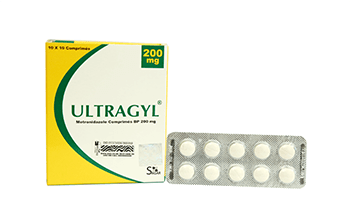
Ultragyl
Each tablet contains: Metronidazole BP 200mg
SYMPTOMATIC TRICHOMONIASIS: Metronidazole is indicated for the treatment of symptomatic trichomoniasis in females and males when the presence of the trichomonad has been confirmed by appropriate laboratory procedures.
ASYMPTOMATIC TRICHOMONIASIS: Metronidazole is indicated in the treatment of asymptomotic females when the organism is associated with endocervicitis, cervicitis, or cervical erosion.
AMOEBIASIS: Metronidazole is indicated in the treatment of acute intestinal amoebiosis (amoebic dysentery) and amebic liver abscess.
INTRA-ABDOMINAL INFECTIONS: Including peritonitis, intra-abdominal abscess, and liver abscess, caused by Bacteroides species including the B. fragilis group (B. fragilis, B. distasonis, B.ovatus, B. thetaiotaomicron, B. vulgatus), Clostridium species, Eubacterium species, Peptococcus niger, and Peptostreptococcus species.
SKIN AND SKIN STRUCTURE INFECTIONS: Bacteroides species including the B.fragilis group, Clostridium species, Peptococcus niger,Peptostreptococcus species, and Fusobacterium species.
GYNECOLOGIC INFECTIONS: Including endometritis, endomyometritis, tuba-ovarian abscess, and postsurgical vaginal cuff infection, caused by Bacteroides species including the B. fragilis group, Clostridium species, Peptococcus niger, and Peptostreptococcus species.
BACTERIAL SEPTICEMIA:Bacteroides species including the B.fragilis group, and Clostridium species.
Metronidazole is an oral synthetic antiprotozoal and antibacterial agent, 1- (B – hydroxyethyl)- 2 – methyl -5-nitroimidozole.
The major route of elimination of metronidazole and its metabolites is via the urine (60 to 80% of the dose), with fecal excretion accounting for 6 to 15% of the dose. The metabolites that appear in the urine result primarily from side-chain oxidation [1- (B – hydroxyethyl) – 2 – hydroxymethyl – 5 -nitroimidozole and 2 – methyl – 5-nitroimidazole -1- yl – acetic acid] and glucuronide conjugation, with unchanged metronidazole accounting for approximately 20% of the total. Renal clearance of metronidazole is approximately 10mL/min/ 1.73 m.
Metronidazole is the major component appearing in the plasma, with lesser quantities of the 2-hydroxymethyl metabolite also being present. Less than 20% of the circulating metronidazole is bound to plasma proteins. Both the parent compound and the metabolite possess in vitro bactericidal activity against most strains of anaerobic bacteria and in vitro trichomonacidal activity. Metronidazole appears in cerebrospinal fluid, saliva, and human milk in concentrations similar to those found in plasma. Bactericidal concentrations of metronidazole have also been – detected in pus from hepatic abscesses. Following oral administration, metronidazole is well absorbed, with peak plasma concentrations occurring between one and two hours after administration. Plasma concentrations of metronidazole are proportional to the administered dose.
Decreased renal function does not alter the single-dose pharmacokinetics of metronidazole. However, plasma clearance of metronidazole is decreased in patients with decreased liver function.
Adults:Amoebiasis: 2 tablets 3 times a day for 5 to 10days.
Giardiasis: 1 tablet 3 times a day for 7 to 10 days.
Children: Amoebiasis: 1 tablet 3 times a day for 5 to 7 days.
Giardiasis: 1/2 tablet 3 times a day for 7 to 10 days, or as directed by the physician.
Metronidazole is contraindicated in patients with a prior history of hypersensitivity to metronidazole or other nitroimidazole derivatives. In patients with trichomoniasis, metronidazole is contraindicated during the first trimester of pregnancy.
General: Patients with severe hepatic disease metabolize metronidazole slowly, with resultant accumulation of metronidazole and its metabolites in the plasma. Accordingly, for such patients, doses below those usually recommended should be administered cautiously. Information for patients: Alcoholic beverages should be avoided while taking metronidazole and for at least one day afterward.
Drug interactions: Metronidazole has been reported to potentiate the anticoagulant effect of warfarin and other oral coumarin anticogulants, resulting in a prolongation of prothrombin time. The simultaneous administration of drugs that decrease microsomal liver enzyme activity, such as cimetidine, may prolong the half-life and decrease plasma clearance of metronidazole. In patients stabilizedl on relatively high dose of lithium, short term. therapy has been associated with elevation of serum lithium and, in a few cases, signs of lithium toxicity. Serum lithium and serum creatinlne levels should be obtained several days after beginning m to detect any increase that may precede clinical rooms of lithium intoxication. Alcoholic beverage should not be consumed during m therapy and for at least one afterward because abdominal vamps, nausea, vomiting, headaches, and flushing may occur. Psychotic reactions have been reported in alcoholic patients who are using metronidazole and disulflram concurrently. should not be given to patients who have taken disulfiram within the last two weeks. Carcinogenesis, mutagenesis, impairment of fertility: has shown evidence of carcinogenic activity in a number of studies involving chronic, oraI administration in mice and rats.
Pregnancy: Metronidazole crosses the placental barrier and enters the fetal circulation rapidly. There are, however, no adequate and well-controlled studies in pregnant women.. Because animal reproduction studies are not always predictive of human response, and because is a carcinogen in rodents, this drug should be used during pregnancy only if clearly needed.
Nursing mothers: Because of the potential for tumorigenicity, shown for in mouse and rat studies, a decision should be made whether to discontinue nursing or to discontinue the drug, taking into account the importance of the drug to the mother. Metronidazole is secreted in human milk in concentrations similar to those found in plasma.
Geriatric use: Decreased renal function doe not alter the single-dose pharmacokinetics of . However, plasma clearance of is decreased in patients with decreased liver function. Therefore, in elderly patients, monitoring of serum levels may be necessary to adjust the dosage accordingly.
Pediatric use: Safety and effectiveness in pediatric patients have not been established, except for the treatment of amoebiasis.
Mouth: Unpleasant metallic taste. Furry tongue, glossitis, and stomatitis have occurred; these may be associated with a sudden overgrowth of Candida which may occur during therapy.
Hematopoietic: Reversible neutropenia (Ieukopenia)
Cardiovascular: FIattening of the T-wave may be seen in electrocardiographic tracings.
Central Nervous System: Convulsive seizures, peripheral neuropathy, dizziness, vertigo, incoordination, ataxia, confusion, irritability, depression, weakness, and insomnia.
Hypersensitivity: Urticaria, erythematous rash, flushing, nasal congestion, dryness of the mouth (or vagina or vulva), and fever.
Renal: Dysuria, cystitis, polyuria, incontinence, and a sense of pelvic pressure.
Metronidazole has been shown to be carcinogenic in mice and rats. Unnecessary use of the drug should be avoided. Its use should be reserved for the conditions described in the indications and usage section.
Store in a cool, dry place of a temperature not exceeding 30°C. Protect from light. Keep all medicines away from reach of children.
10 x 10’s & 1000’s
04-1534
6154000136000
